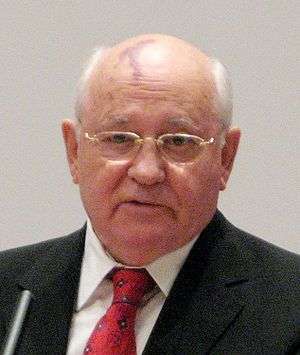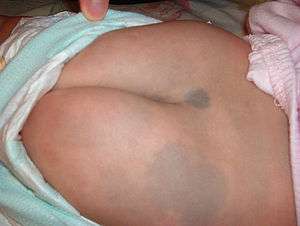Birthmark
| Birthmark | |
|---|---|
|
Mongolian spot visible on six-month-old baby | |
| Classification and external resources | |
| Specialty | Dermatology |
| ICD-10 | Q82.5 |
| ICD-9-CM | 757.32 |
A birthmark is a congenital, benign irregularity on the skin which is present at birth or appears shortly after birth, usually in the first month. They can occur anywhere on the skin.[1] Birthmarks are caused by overgrowth of blood vessels, melanocytes, smooth muscle, fat, fibroblasts, or keratinocytes.
Dermatologists divide birthmarks into two types. Pigmented birthmarks caused by excess skin pigment cells include moles, café au lait spots, and Mongolian spots. Vascular birthmarks, also called red birthmarks, are caused by increased blood vessels and include macular stains (salmon patches), hemangiomas, and Port-wine stains. A little over 1 in 10 babies have a vascular birthmark present by age 1.[2] Several birthmark types are part of the group of skin lesions known as nevi or naevi, which means "birthmarks" in Latin.
The exact cause of most birthmarks is unknown, but they are thought to occur as a result of a localized imbalance in factors controlling the development and migration of skin cells. In addition, it is known that vascular birthmarks are not hereditary.[2][3]
Pigmented types
Mole
Congenital melanocytic nevus is a type of melanocytic nevus, the medical term for what is colloquially called a "mole", found in infants at birth. Occurring in about 1% of infants in the United States, it is located in the area of the head and neck 15% of the time, but may occur anywhere on the body. It may appear as light brown in fair-skinned people, to almost black in people with darker skin. Coming in a variety of sizes and appearances, they may be irregular in shape and flat, or raised and lumpy in appearance and feel. Such naevi can also manifest themselves as beauty marks, which most commonly appear on the face, neck or arms.
Café au lait spot
Café au lait spot macules may occur anywhere on the body. They are most commonly oval in shape and light brown, or milk coffee, in color. These birthmarks may be present at birth, or appear in early childhood, and do not fade much with age.[4] One or two on an individual is common;[4] however, four or more may be an indicator of neurofibromatosis.[4] In the event of weight gain, the birthmark can stretch with the skin and become larger.
Mongolian spot
A Mongolian blue spot (dermal melanocytosis) is a benign flat congenital birthmark with wavy borders and irregular shape, most common among East Asians and Turkic people (excluding Turks of Asia Minor), and named after Mongolians. It is also extremely prevalent among East Africans and Native Americans.[5][6] It normally disappears three to five years after birth and almost always by puberty. The most common color is blue, although they can be blue-gray, blue-black or even deep brown.
The Mongolian spot is a congenital developmental condition exclusively involving the skin. The blue colour is caused by melanocytes, melanin-containing cells, that are deep under the skin.[6] Usually, as multiple spots or one large patch, it covers one or more of the lumbosacral area (lower back), the buttocks, sides, and shoulders.[6] It results from the entrapment of melanocytes in the dermis during their migration from the neural crest to the epidermis during embryonic development.[6]
Among those who are not aware of the background of the Mongolian spots, it may sometimes be mistaken for a bruise indicative of child abuse.[7]
Vascular types
Stork bite
Colloquially called a "stork bite", "angel's kiss" or "salmon patch", telangiectatic nevus appears as a pink or tanned, flat, irregularly shaped mark on the knee, back of the neck, and/or the forehead, eyelids and, sometimes, the top lip. The skin is not thickened and feels no different from anywhere else on the body; the only difference is in appearance. Nearly half of all babies have such a birthmark.[4]
Strawberry mark
A "hemangioma of infancy", colloquially called a strawberry mark, is a benign self-involuting tumor (swelling or growth) of endothelial cells, the cells that line blood vessels. It usually appears during the first weeks of life and resolves by age 10. It is the most common tumor of infancy.[8]
PHACES Syndrome, a rare condition that often involves brain, heart, and arterial abnormalities, is generally accompanied by the presence of large facial hemangiomas. In such cases, what appears to be a small bruise or birthmark may grow rapidly and take on a puffy appearance in the first days or weeks of life.
Port-wine stain

Port-wine stains, also known as nevus flammeus and sometimes mistaken for strawberry marks, are present at birth and range from a pale pink in color, to a deep wine-red. Irregular in appearance, they are usually quite large, and caused by a deficiency or absence in the nerve supply to blood vessels. This causes vasodilation, the dilation of blood vessels, causing blood to pool or collect in the affected area.[9] Over time, port-wine stains may become thick or develop small ridges or bumps, and do not fade with age.[2] Such birthmarks may have emotional or social repercussions.[2] Port-wine stains occur in 0.3% of the population, equally among males and females.[2][9] They frequently express unilaterally, i.e., on only one side, not crossing the midline of the body. Often on the face, marks on the upper eyelid or forehead may be indicative of a condition called Sturge-Weber syndrome. Additionally, port-wine stains in these locations may be associated with glaucoma and seizures.[2]
Treatment
Most birthmarks are harmless and do not require treatment. Pigmented marks can resolve on their own over time in some cases. Vascular birthmarks may require reduction or removal for cosmetic reasons. Treatments include administering oral or injected steroids, dermatological lasers to reduce size and/or color, or dermatologic surgery.
Folklore
Birthmarks are called voglie in Italian, antojos in Spanish, and wiham in Arabic; all of which translate to "wishes" because, according to folklore, they are caused by unsatisfied wishes of the mother during pregnancy. For example, if a pregnant woman does not satisfy a sudden wish or craving for strawberries, it's said that the infant might bear a strawberry mark.
In Dutch, birthmarks are called moedervlekken, in Danish modermærke and in German Muttermal, all meaning "mother-spots" because it was thought that an infant inherited the marks solely from the mother. The Hungarian word for any flat mole, as opposed to only congenital birthmarks, anyajegy, is also derived from this belief.
Some myths associated with birthmarks are that they are caused when an expectant mother sees something strange, or experiences a great deal of fear, sometimes called a maternal impression.[4]
In Iranian folklore, a birthmark appears when the pregnant mother touches a part of her body during a solar eclipse.
In Ethiopian Orthodox Christianity folklore, a birthmark is considered a "kiss of St. Mary the virgin".
According to modern American folklore in the New Age community, birthmarks sometimes indicate the site of traumatic injuries in a past life.[10][11][12]
References
- ↑ "birthmark" at Dorland's Medical Dictionary
- 1 2 3 4 5 6 "Birthmarks". American Academy of Dermatology. Retrieved 2011-06-20.
- ↑ "Birthmarks". Seattle Children's Hospital and Regional Medical Center. Retrieved 2008-08-02.
- 1 2 3 4 5 "Parenting and Child Health - Health Topics - Birthmarks".
- ↑ About Mongolian Spot
- 1 2 3 4 Mongolian blue spots - Health care guide discussing the Mongolian blue spot.
- ↑ Mongolian Spot - English information of Mongolian spot, written by Hironao NUMABE, M.D., Tokyo Medical University.
- ↑ Haggstrom AN, Drolet BA, Baselga E, et al. (September 2006). "Prospective study of infantile hemangiomas: clinical characteristics predicting complications and treatment". Pediatrics. 118 (3): 882–7. doi:10.1542/peds.2006-0413. PMID 16950977.
- 1 2 "Port Wine Stain Information". Vascular Birthmark Foundation. Retrieved 2008-08-02.
- ↑ B. Alan Wallace (2009). Mind in the balance: meditation in science, Buddhism, & Christianity. Columbia University Press. p. 107. ISBN 978-0-231-14730-9.
- ↑ Daniel J. Benor (2006). Personal Spirituality. Wholistic Healing Publications. p. 51. ISBN 978-0-9754248-4-1.
- ↑ Sylvia Browne; Lindsay Harrison (2007). Psychic Children: Revealing the Intuitive Gifts and Hidden Abilities of Boys and Girls. Penguin. p. 124. ISBN 978-0-525-95013-4.
